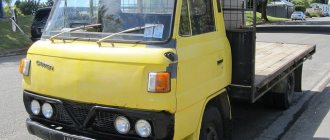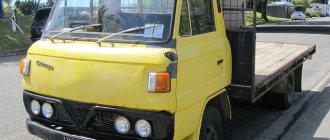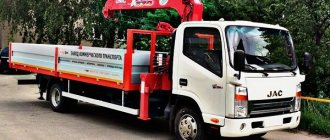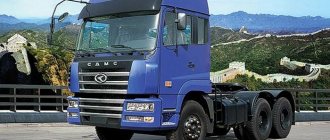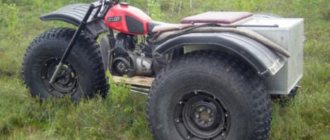The first Canter model trucks began to appear on Russian roads in the early 90s of the last century. At that time, a large number of used right-hand drive cars of this model were imported. Since 2009, the production of trucks fully adapted to Russian roads began in Naberezhnye Chelny, which significantly increased consumer interest in this model. Owners note the reliability, efficiency and relatively low cost of the car.
Features of the Fuso Canter car
In the 90s, more than 30 thousand right-hand drive cars of this brand were imported into Russia. The buyers of these trucks, as a rule, were private entrepreneurs or summer residents who wanted an inexpensive and economical vehicle for transporting medium-tonnage cargo for their own purposes. The unusual position of the steering wheel for Russian road traffic did not deter buyers, because the build quality of this model was at a high level.
Japanese and Russian-made trucks have significant differences. Right-hand drive cars are equipped with engines with mechanical fuel supply. And Russian-assembled engines are equipped with a modern Common Rail system. The new version is equipped with wheels of larger diameter (15 inches instead of 14). The spring suspension of used cars negatively affects the smoothness of the ride.
The steering wheel position, unusual for Russian road traffic, did not deter Mitsubishi Fuso Canter buyers
The cost of a new Fuso Canter truck is on average 1.5 million rubles. Car enthusiasts justifiably believe that this is a very low price for a car with such parameters. But trucks imported from Japan cost even less - 200-300 thousand rubles. At the same time, the quality of the Japanese assembly was at a fairly high level. Also, those who want to save money can pay attention to the fact that the Canter model is suitable for Korean springs from the Hyundai Mighty, which are several times cheaper than the original Japanese parts. And you can select quite a lot of such replacements, which makes the car very economical.
Korean springs from Hyundai Mighty are suitable for the Canter model
About the history of the model
The Canter medium-duty truck model is the flagship of Mitsubishi Fuso, which has more than 50 years of production history and progressive technical evolution. The first generation Mitsubishi Fuso Canter was launched on the market in March 1963. Manufacturers compared the T72O truck with a cabover layout, which has a load capacity of 2 tons, to a horse and called it Canter, which translated from English means “light gallop.”
The model was completely updated by July 1968, when the Canter T90 series was released. Its range of engines includes a 75-horsepower diesel engine and gasoline carburetor engines with a power of 9O and 95 hp.
In 1973, the next generation was launched into the series - T2OO trucks. Both the cabin and the engines were significantly redesigned (gasoline power increased to 95 and 100 hp and to reduce harmful emissions the MCA system was introduced, with two intake valves per cylinder). The fourth generation Canter came out in October 1978, and the fifth in the same month of 1985.
Various modifications
Japanese manufacturers produce many varieties of the Fuso Canter model. Each modification has its own characteristics, because cars are manufactured for different purposes and operating conditions. For each country, certain types of trucks are supplied, which have their own distinctive features.
On Russian roads you can most often find the sixth generation Canter with right-hand drive. This model has the index TB and the Japanese VIN code, which begins with a letter. Also in Russia there is a modification of the seventh generation TD, which has been produced since 2002. This type of Canter is equipped with a Common Rail engine.
Each of the Mitsubishi Fuso Canter modifications has its own characteristics, because cars are manufactured for different purposes and operating conditions
Models weighing 8.5 tons with rear-wheel drive are produced in Naberezhnye Chelny. The trucks are equipped with a single-row cab and an engine with a displacement of 4.9 liters. The car is environmentally friendly (Euro-4 standard). The load capacity is 5.3 tons, which is 800 kilograms more than the previous model. The front suspension has been improved. The engine became more powerful by 30 horsepower.
About the history of the model
The Canter medium-duty truck model is the flagship of Mitsubishi Fuso, which has more than 50 years of production history and progressive technical evolution. The first generation Mitsubishi Fuso Canter was launched on the market in March 1963. Manufacturers compared the T72O truck with a cabover layout, which has a load capacity of 2 tons, to a horse and called it Canter, which translated from English means “light gallop.”
The model was completely updated by July 1968, when the Canter T90 series was released. Its range of engines includes a 75-horsepower diesel engine and gasoline carburetor engines with a power of 9O and 95 hp.
In 1973, the next generation was launched into the series - T2OO trucks. Both the cabin and the engines were significantly redesigned (gasoline power increased to 95 and 100 hp and to reduce harmful emissions the MCA system was introduced, with two intake valves per cylinder). The fourth generation Canter came out in October 1978, and the fifth in the same month of 1985.
This is what Mitsubishi Canter was like in 1968-1973.
The sixth generation Canter, mass-produced since November 1993, has become a global bestseller, including in Russia (in our country, however, in a used version). The car is distinguished by an advanced (for that time) cabin design with excellent aerodynamic characteristics, the most powerful 140-horsepower diesel engine in this class with direct fuel injection and 2 overhead camshafts. For the first time in its class, the Canter was equipped with independent front suspension.
Another progressive innovation was introduced for the first time in the world on cabover trucks in 2002: the manual gearbox lever was built directly into the dashboard. Since 2006, the line of engines for Canter has included not only diesel engines with power from 110 to 180 hp, but also hybrid engines.
Mitsubishi Fuso Canter officially came to Russia in 2010, and in 2022, assembly production and sales of a new generation, the Canter TF, started in our country. In Tatarstan, Canters are assembled in two versions: with a total weight of 7.5 tons and 8.55 tons. Their carrying capacity, respectively, is up to 5 and up to 6 tons.
Exterior
The design ergonomics of the new generation Canter are at a very high level. Comfortable entry and exit is ensured by the high cabin and spacious doorway. The door opens almost 90 degrees. Halogen headlights, optimally positioned rear-view mirrors and an updated radiator grille make the car's design very stylish and functional.
Basic elements of a car's exterior
- wide cabin, which provides good visibility for the driver even when installing large vans;
- modern headlights allow you to move safely at night;
- a bumper made of polymer has a corrosion protection function;
- a rubber gutter is installed on the cabin, which is designed to drain water from the roof;
- good cleaning of the windshield is ensured by nozzles that move together with the wipers, spraying liquid over the entire surface;
- the cabin is completely zinc-treated (more than half of the car’s parts are made of anti-corrosion materials).
The wide cab provides good visibility for the driver even when installing large vans
Ease of operation and maintenance
To carry out service work, the cab must be tilted using the control lever. The developers of the Canter truck have located it behind the cab on the passenger side of the door, which has a positive effect on the safety of the driver if it is necessary to carry out inspections or repairs directly on the highway.
Chassis of Mitsubishi Fuso Canter. Photo
The brake and washer fluid tanks are filled from the cab. The coolant tank is translucent, which makes it possible to control its level with maximum comfort.
Interior
The interior has been designed to provide maximum driver comfort and convenience. Excellent sound insulation is achieved due to the suspended mounting of the cabin and double sealing of the doors. The spacious cab offers plenty of storage space.
A comfortable ride is ensured by a wide range of adjustment of the driver's seat. This feature prevents driver fatigue, which is very important for safety on long trips. The backrest can tilt forward 8 degrees and tilt back 30 degrees. The seat moves back 19 cm.
The gear shift lever is located on the instrument panel - this is an innovation for cars in which the engine is located under the cab. This function allows the driver to take a comfortable position when driving and allows him to move freely around the cabin. All controls are located on the instrument panel in such a way that the driver does not have to reach for them.
The controls are located on the instrument panel so that the driver does not have to reach for them
The steering wheel position is adjustable in angle and height. The parking brake is located next to the driver's seat. The load on the driver's legs is reduced due to the optimal placement of the pedals, in which the difference in the height of the brake and gas is minimal. Thanks to the short clutch stroke, a comfortable gear shifting process is ensured.
The seat, which is located in the center, can be folded, turning it into a table. The driver's seat is equipped with a pocket for storing documents. Easy access to fluid reservoirs makes this car extremely easy to use.
Device
The design of the Mitsubishi Fuso Canter is distinguished by the presence of the RISE system, which increases the safety of the driver and passengers. It includes:
- door beams that protect in the event of side collisions;
- front beams that deform in the longitudinal direction during a frontal collision;
- reinforcements for the cabin block.
The load-bearing frame also has special stiffening ribs that allow it to withstand the superstructure and heavy loads. The chassis of the Fuso Canter was built on the basis of the Fuso Fighter model with a higher load capacity.
The design of vans, chassis, flatbed vehicles and other versions of the series is practically the same. They are based on a frame staircase structure. The front and rear suspensions are dependent with leaf springs, anti-roll bar and double-acting telescopic shock absorbers that dampen vibrations. The front uses single-ply tires measuring 215/75R17.5, and the rear uses dual-ply tires measuring 215/75R17.5.
All versions of the Mitsubishi Fuso Canter use a transmission that includes a manual gearbox (6 forward speeds, 1 reverse speed) and a dry-type single-plate clutch with a diaphragm pressure spring and hydraulic drive. The reverse and first gear gears have constant mesh, the rest are synchronized.
The car uses a combined braking system, including:
- service brake – 2-circuit with drum elements and anti-lock system. On some modifications, discs are installed in front;
- parking brake - a system with expanding shoes in the drum;
- The mountain brake is a vacuum element with a throttle valve.
The car is equipped with a cabin with a unique architecture and halogen headlights, adding to its attractiveness. The large windshield and cleverly positioned mirrors provide excellent visibility in all directions. The cabin is equipped with a step to facilitate entry into the cabin. While driving, it is completely closed by the door to prevent snow and dirt from entering. Due to the high opening, you can get into the cabin without bending over. The driver's seat is very comfortable and has individual settings for maximum comfort. The reach is 192 mm, the back angle can be adjusted from 8 degrees forward to 30 degrees back.
The interior of the Mitsubishi Fuso Canter is quite boring, since the design is “stuck” somewhere in the 1990s. The priority here is comfort and practicality. The gearshift lever is located on the dashboard, not by the seats, which is very convenient. The steering wheel, lumbar support and backrest are adjustable. The passenger seat has 2 glove compartments, one of which is locked with a key. A special niche in A4 format allows you to carry a package of documents with you. The steering has a hydraulic booster.
New optics help you move safely in the dark. The bumper is made of durable synthetic material and has an anti-corrosion coating.
For maintenance or repairs, the vehicle's cab can be easily tilted using the control lever located at the rear of the passenger door. Refilling washer and brake fluid is done from the cab.
Engine
The car is equipped with a 4M50-5AT5 engine. Power is 180 horsepower, torque is 530 Nm. With all its power, the motor is economical and environmentally friendly. The fuel consumption of an empty car is 17 liters per 100 kilometers, a loaded one is 19 liters per 100 kilometers .
Japanese designers managed to find a balance between power and efficiency. After all, an engine with a smaller displacement will not withstand serious loads, and with a larger one it will lead to a significant increase in fuel costs. Optimal torque is provided by camshafts, a turbocharger and the Common Rail system, which is responsible for fuel supply. Due to the location of the working cylinder above the gearbox, the clutch operates easier, which increases its service life.
The car is equipped with a 4M50-5AT5 engine
Steering and instrument panel Technical capabilities
Otherwise, with gentle operation, everything is the same as on other 15-20 year old Japanese cars, from time to time you have to replace some parts while waiting for a major engine overhaul. Its exhaust quality fully complies with Euro-4 standards, and its efficiency and productivity allow it to cope with the assigned tasks with maximum efficiency.
| Onboard platform options: | Steel | Aluminum |
| Side material: | Steel | Aluminum |
| Side color: | Grey | not painted |
| Side height: | 485 mm. | 400 mm. |
| Platform and rack color: | Black | |
| Flooring: | Laminated plywood mesh wear-resistant | |
Technical characteristics of Mitsubishi Fuso Canter
Various types of superstructures can be installed on the Canter truck chassis. This contributes to the vehicle's versatility. This model can be used for municipal, construction and agricultural purposes. The technical parameters of the car are as follows:
| Chassis model | E |
| Dimensions: | |
| Height | 2.2 m |
| Length | 5.9 m |
| Width | 2.1 m |
| Wheelbase | 3.4 m |
| Clearance | 20 cm |
| Frame width | 84 cm |
| Front overhang | 1.1 m |
| Track: | |
| - rear | 1.66 m |
| - front | 1.67 m |
| Cabin: | |
| - to the end of the frame | 4.3 m |
| - to the rear axle | 2.9 m |
| Rear overhang | 1.4 m |
| Engine: | |
| Model | 4M50-5AT5 |
| Type | Diesel turbocharged |
| Power | 180 hp |
| Speed at maximum power | 2700 rpm |
| Torque | 530 Nm |
| Speed at maximum torque | 1600 rpm |
| Air purifier | dry |
| Generator | 80 A |
| Number of cylinders | 4 |
| Volume | 4.9 l |
| Masses: | |
| Full | From 4.5 to 8.5 tons, depending on configuration |
| Equipped | 2.8 t |
| Road train | 12 tons |
| Trailer | 3.5 t |
| Performance characteristics: | |
| Maximum speed | 108 km/h |
| Fuel consumption | 19 liters per 100 kilometers |
| Climbing | 34 degrees |
| Transmission: | |
| checkpoint | manual 6-speed gearbox |
| Gear ratio range | 5,4 — 0,71 |
| Clutch | single-disk |
| Chassis: | |
| Steering | telescopic steering column |
| Shock absorbers | double-sided hydraulic |
| Axles: | |
| - rear | axle shafts are unloaded |
| - front | the beam has an I-section |
| Brake: | |
| - parking | drum |
| - worker | double-circuit drum with ABS |
| - mountain | vacuum |
| Fuel tank | 100 l |
| Battery | 110 Ah |
| Cabin design | Folding, made of solid steel |
| Number of seats | 3 |
Owner reviews
Ivan from Arkhangelsk:
“In 2012, 3 new trucks of this model were purchased for our enterprise. All cars currently have a mileage of approximately 200 thousand kilometers. I want to say right away that the condition of the engines is very good. There are also disadvantages. There was a crack in the cast iron casting of one of the trucks, causing an antifreeze leak. The same car had a defective water pump installed. The radiator on the other car was leaking.”
Sergey from Kursk:
“Two years ago, our company’s fleet was replenished with six cars of this model. During this time, the trucks traveled an average of 150 thousand kilometers. Cars often drive with overload, but so far there have been no problems with the suspension. Almost all cars had problems with heater radiators. We replaced them under warranty.”
Evgeniy from Samara:
“The car has a very reliable suspension. It can withstand quite heavy loads. At the same time, heaters are often produced with defects. Fuel consumption in practice turned out to be higher than that specified by the manufacturer. In the city in summer the car consumes 22 liters per 100 kilometers. In winter, consumption reaches 24 liters.”
The warranty provided by the Japanese manufacturer is 100 thousand kilometers or 3 years. Buyers choose this car due to its low price and good build quality.
Manipulator: Mitsubishi Fuso Canter cargo loader – 14788
The Fuso brand manipulator from the Japanese company Mitsubishi is an excellent mid-class manipulator. The crane of this device has a lifting capacity of up to five tons. The loading capacity of the vehicle platform can reach eight tons. Speaking about this manipulator, it is necessary to note the excellent Japanese quality and maximum reliability.
The Fuso brand manipulator from the Japanese company Mitsubishi is an excellent mid-class manipulator. The crane of this device has a lifting capacity of up to five tons. The loading capacity of the vehicle platform can reach eight tons. Speaking about this manipulator, it is necessary to note the excellent Japanese quality and maximum reliability.
In addition to excellent technical characteristics, the Fuso manipulator stands out among analogues for its endurance and ability to operate smoothly under any climatic and weather conditions. This may be especially important if this Mitsubishi installation is used in the northern regions of the country or in winter, when the air temperature is less than -20 degrees.
Structurally, the Fuso automanipulator is designed as an onboard vehicle designed for transporting various cargoes. The crane provides this truck with the ability to independently load and unload transported goods. An important point is also that if this manipulator is installed on the vehicle, the driver can cope with loading and unloading work independently. In this case, appropriate permits are required. As a result, the costs associated with attracting additional labor are significantly reduced. In addition, the truck on which the Fuso manipulator is installed is capable of performing other quite complex operations, for example:
- Raising and lowering loads due to obstacles such as walls, fences, etc.;
- Working with loads located below ground level.

